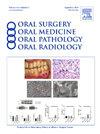可能的寻常性天疱疮爆发:病例系列
IF 1.9
3区 医学
Q2 DENTISTRY, ORAL SURGERY & MEDICINE
Oral Surgery Oral Medicine Oral Pathology Oral Radiology
Pub Date : 2025-07-21
DOI:10.1016/j.oooo.2025.04.068
引用次数: 0
摘要
背景:寻常型天疱疮是一种自身免疫性疾病,引起皮肤和/或粘膜起泡。这是口腔中最常见的基底上裂病,口腔经常表现出这种情况的第一个迹象。虽然天疱疮仍然是一种严重的疾病,但通常可以用现代医学的进步来治疗。在临床实践中,寻常性天疱疮多见于中年女性。我们描述了三例男性寻常性天疱疮患者。病例描述:25岁、30岁和50岁的健康男性患者表现为口腔多灶性疼痛糜烂和溃疡。第二组和第三组患者的皮肤上也有水疱和溃疡。这些病变出现在注射COVID-19疫苗几周后。从口腔病变或皮肤病变处进行活检。所有标本均显示基底上上皮分离伴棘层溶解。采用直接免疫荧光法和抗粘粒蛋白ELISA法进一步研究。这些检查证实了寻常性天疱疮的诊断。治疗包括局部类固醇、全身类固醇和利妥昔单抗(抗cd20单克隆抗体,IV)。结论非典型年龄和性别的健康人群中免疫介导性疾病的发生率可能有所上升。如果诊断为寻常型天疱疮,进一步的临床病史包括询问COVID-19感染/疫苗接种,以进一步评估任何可能的联系。本文章由计算机程序翻译,如有差异,请以英文原文为准。
Possible pemphigus vulgaris outbreak: case series
Background
Pemphigus vulgaris is an autoimmune disease that causes blisters on skin and/or the mucous membrane. It is the most common suprabasilar splitting disease in the oral cavity, with the oral cavity often showing the first signs of this condition. Though still a serious disease, pemphigus vulgaris can usually be treated with modern medical advances. In clinical practice, pemphigus vulgaris is most often seen in middle-aged female. We describe three cases of pemphigus vulgaris in male patients.
Case description
25-year-old, 30-year-old, and 50-year-old healthy male patients presented with multifocal painful erosions and ulcerations in the oral cavity. The second and third patients also had blisters and ulcers on their skin. The lesions appeared a few weeks following the injection of the COVID-19 vaccine. Biopsies were performed from either the oral lesions or skin lesions. All specimens displayed suprabasilar epithelial separation with acantholysis. Further investigation with direct immunofluorescence testing, and anti-desmoglein ELISA were conducted. These tests confirmed the diagnosis of pemphigus vulgaris. The treatment included topical steroids, systemic steroids, and Rituximab (anti-CD20 monoclonal antibody, IV).
Conclusion
There may be a rise in immune-mediated diseases in previously healthy patients of atypical age and gender demographics. If pemphigus vulgaris is diagnosed, further clinical history to include asking about COVID-19 infection/vaccination may be of interest to further evaluate any possible connection.
求助全文
通过发布文献求助,成功后即可免费获取论文全文。
去求助
来源期刊

Oral Surgery Oral Medicine Oral Pathology Oral Radiology
DENTISTRY, ORAL SURGERY & MEDICINE-
CiteScore
3.80
自引率
6.90%
发文量
1217
审稿时长
2-4 weeks
期刊介绍:
Oral Surgery, Oral Medicine, Oral Pathology and Oral Radiology is required reading for anyone in the fields of oral surgery, oral medicine, oral pathology, oral radiology or advanced general practice dentistry. It is the only major dental journal that provides a practical and complete overview of the medical and surgical techniques of dental practice in four areas. Topics covered include such current issues as dental implants, treatment of HIV-infected patients, and evaluation and treatment of TMJ disorders. The official publication for nine societies, the Journal is recommended for initial purchase in the Brandon Hill study, Selected List of Books and Journals for the Small Medical Library.
 求助内容:
求助内容: 应助结果提醒方式:
应助结果提醒方式:


